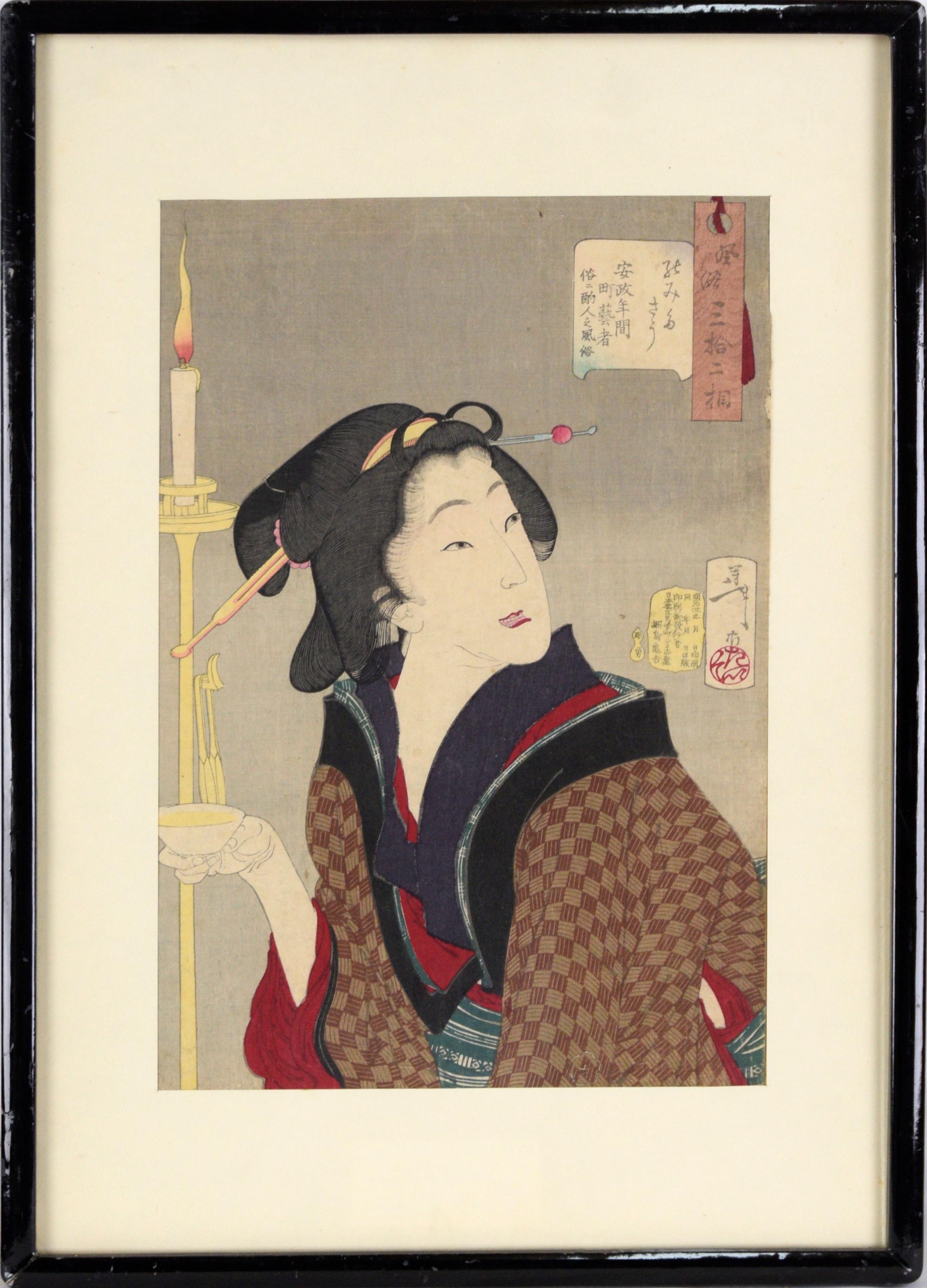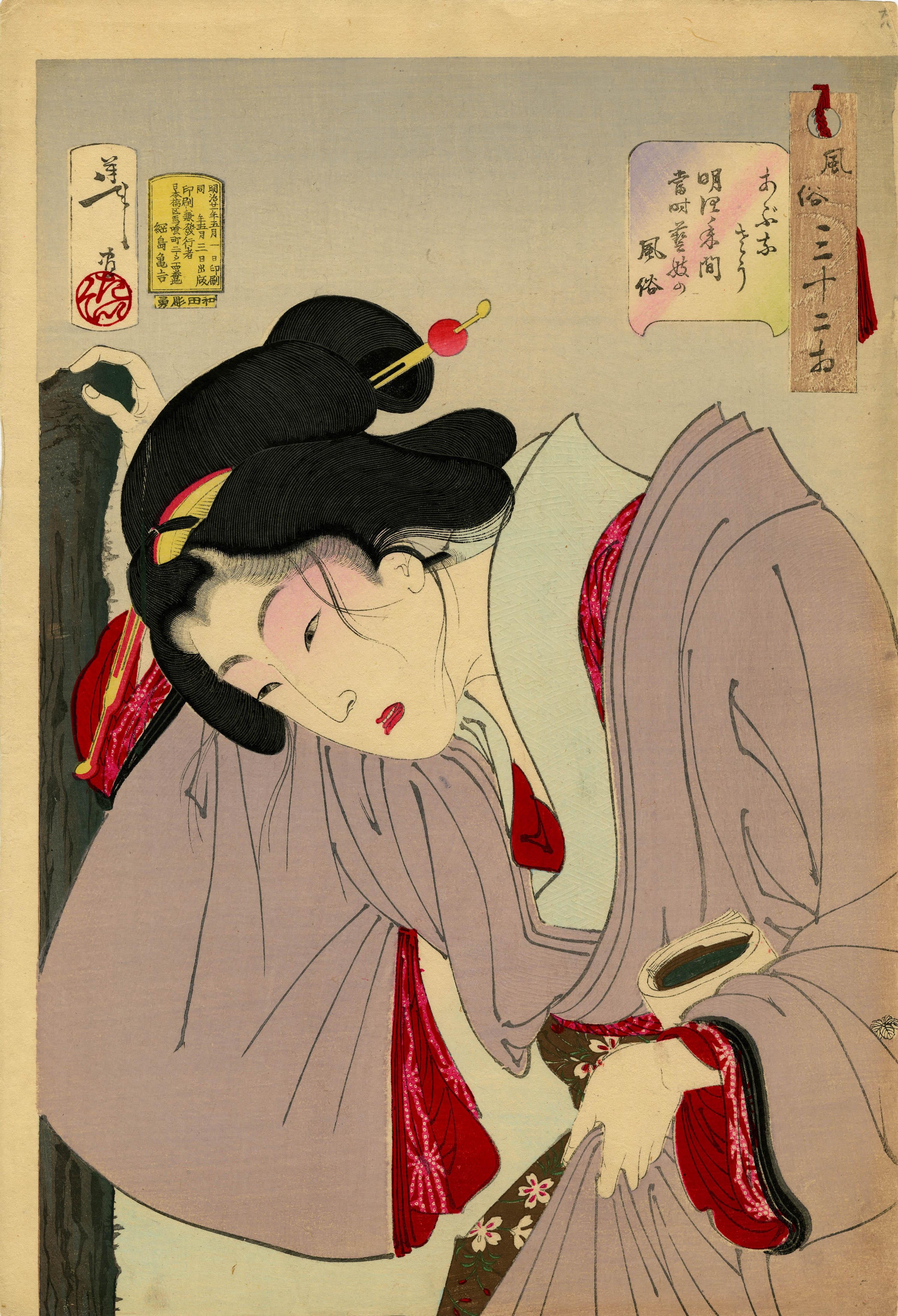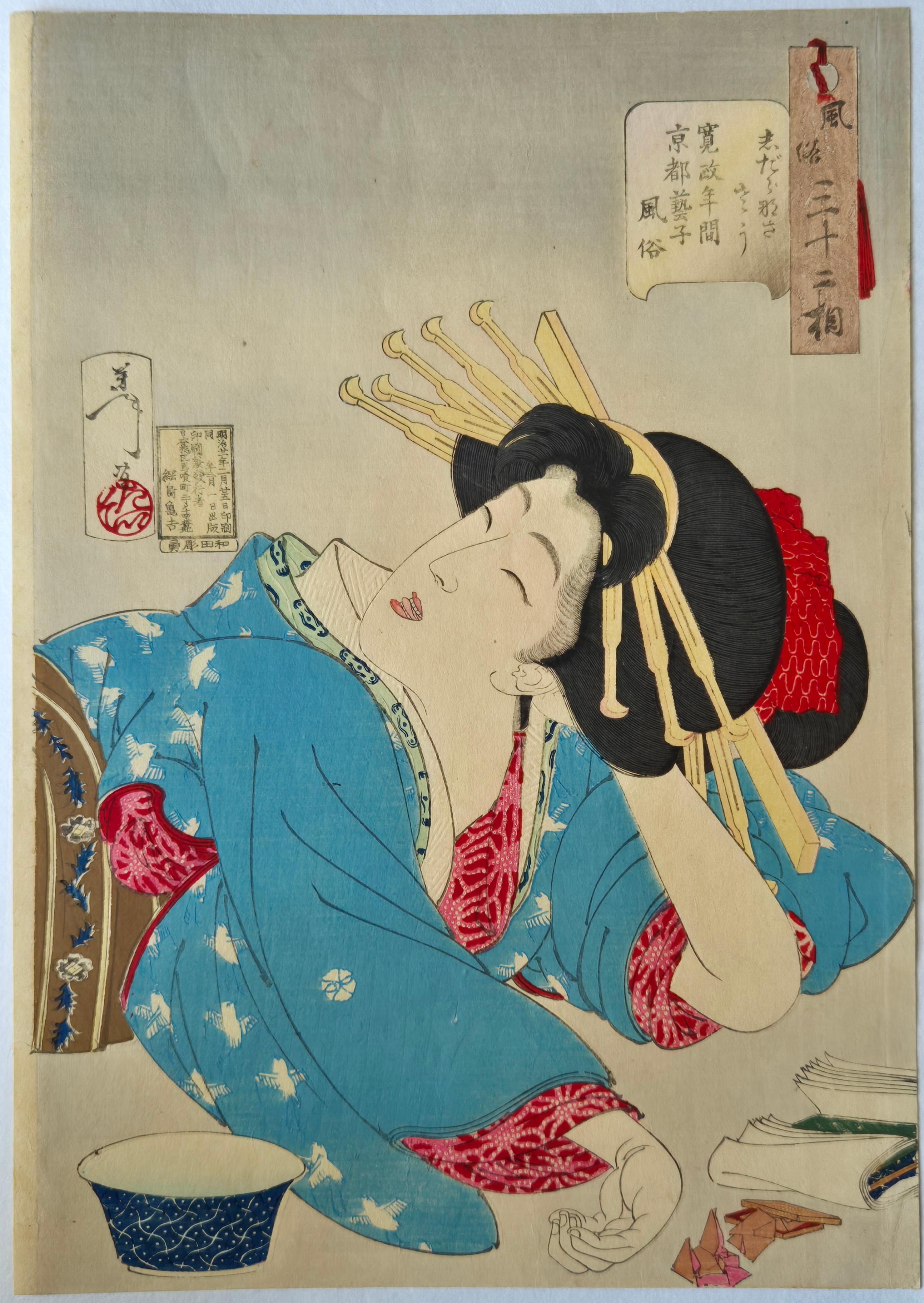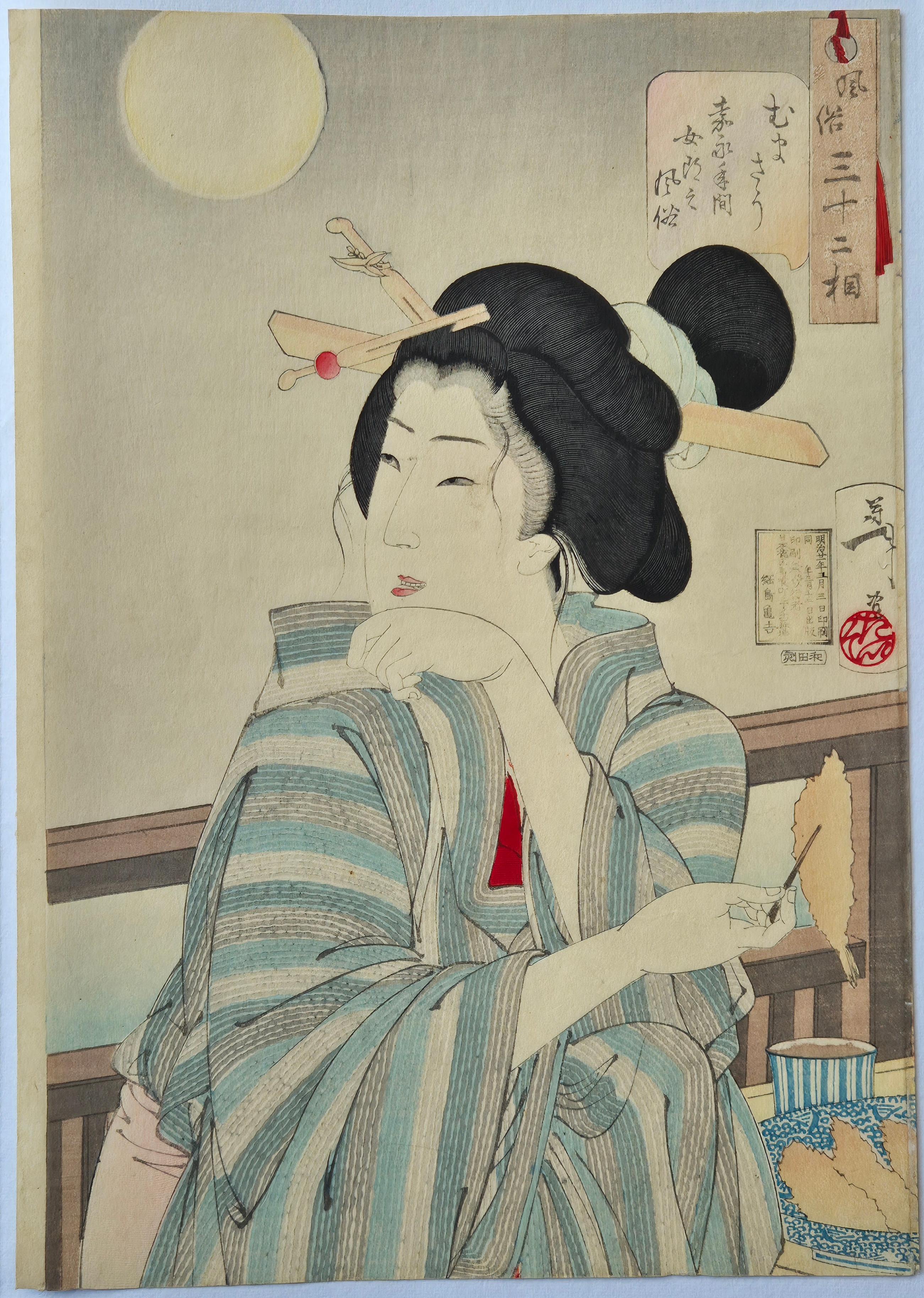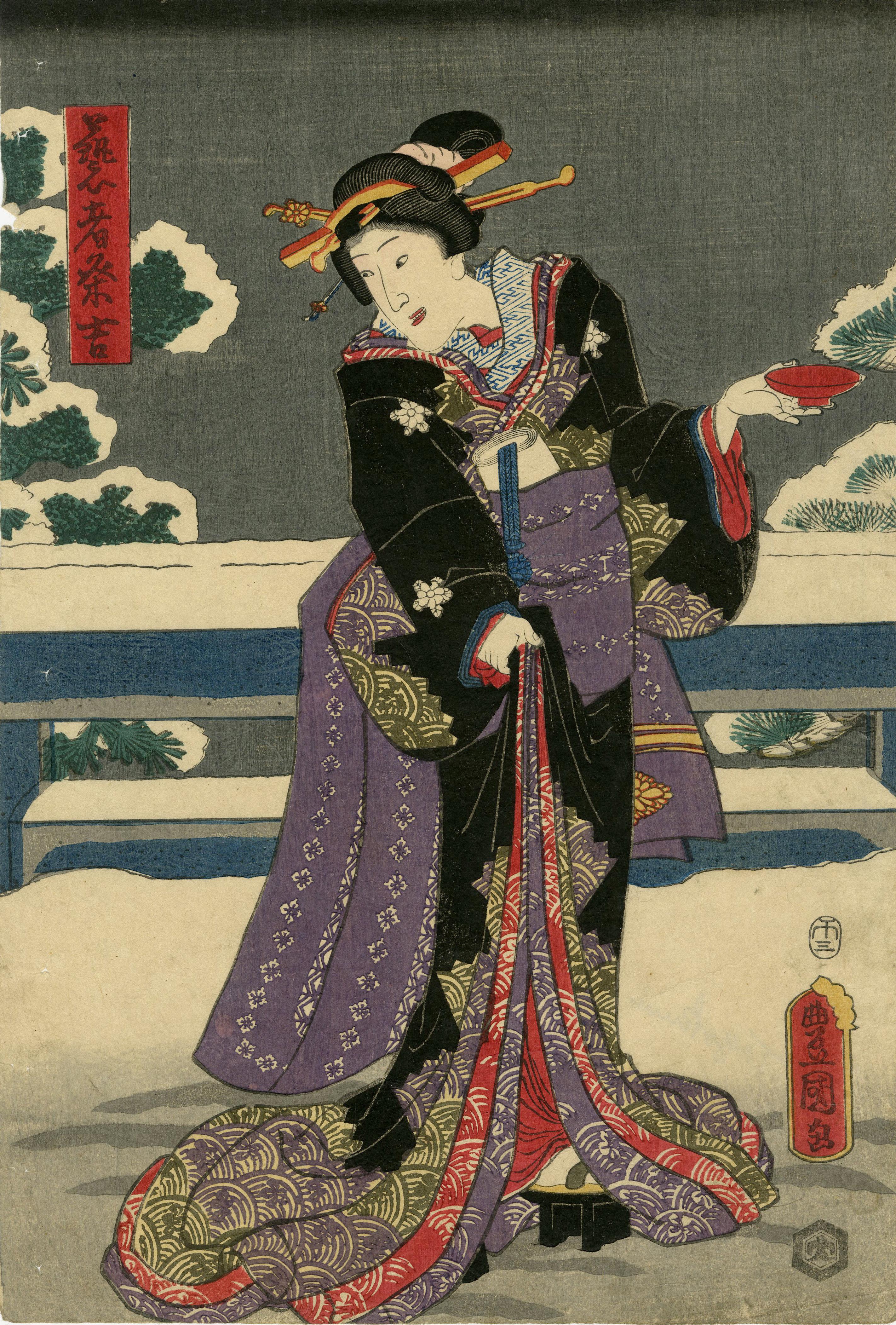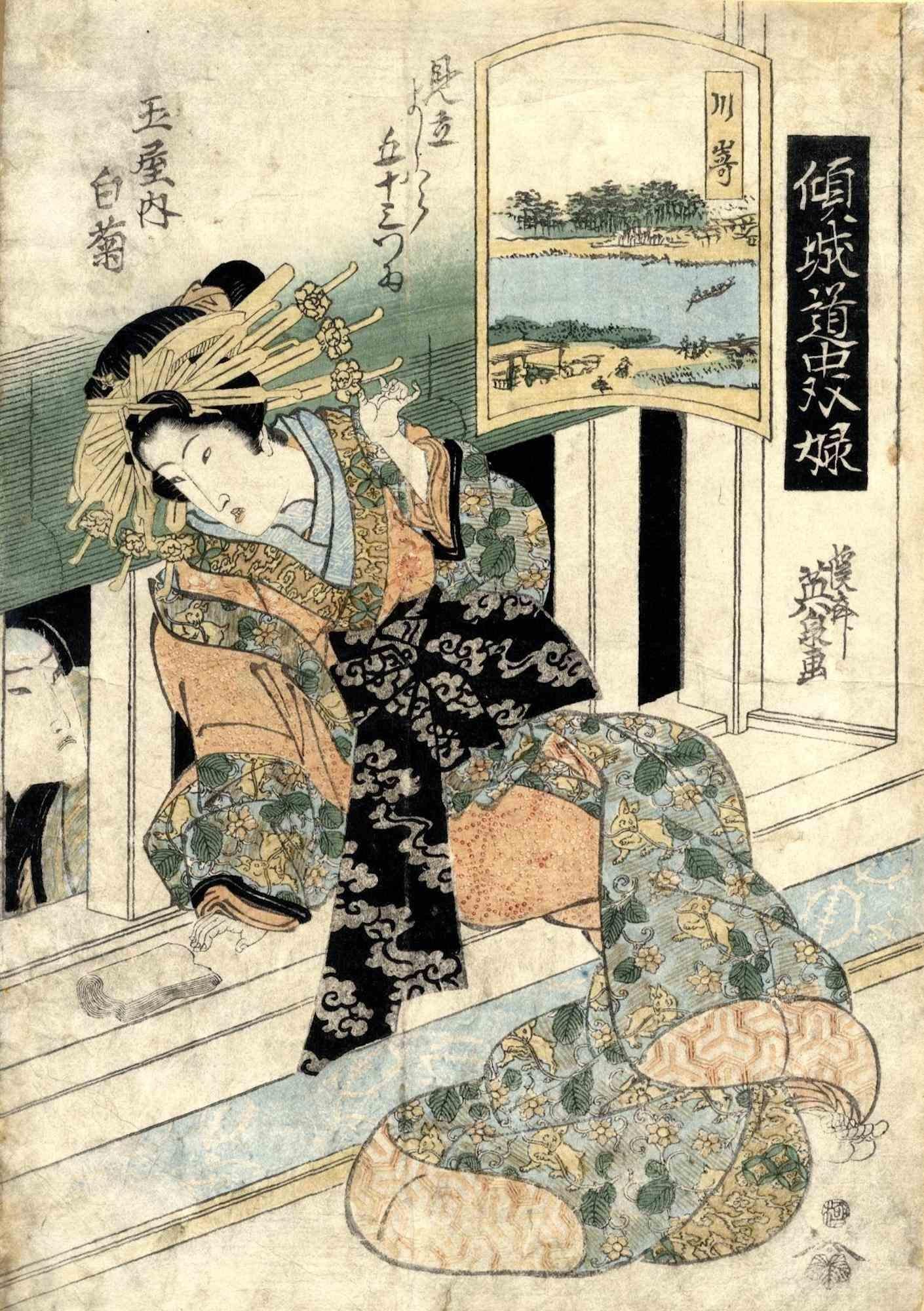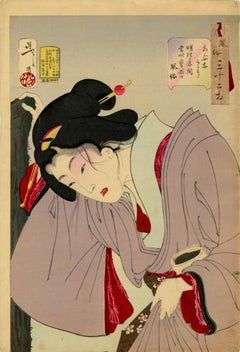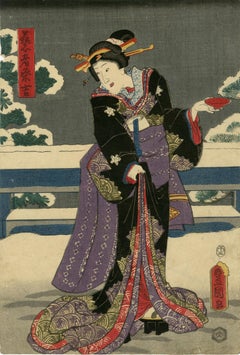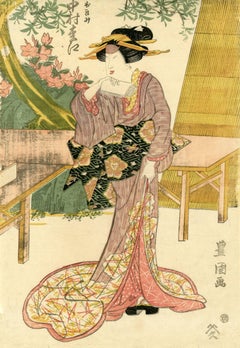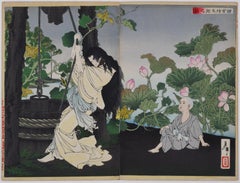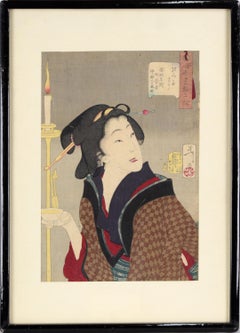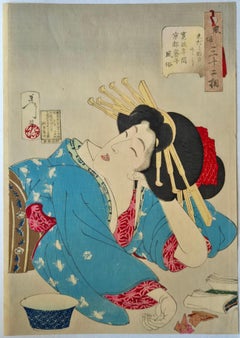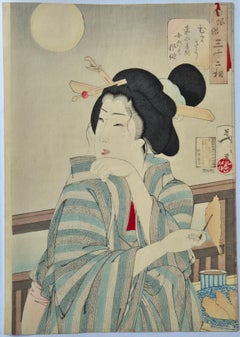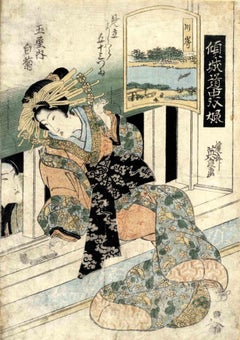Items Similar to Thirsty: The Appearance of a Town Geisha - a So-Called Wine-Server - in the Anse
Want more images or videos?
Request additional images or videos from the seller
1 of 7
Taiso YoshitoshiThirsty: The Appearance of a Town Geisha - a So-Called Wine-Server - in the Anse1888
1888
$1,800
£1,401.39
€1,593.60
CA$2,587.89
A$2,842
CHF 1,484.15
MX$33,920.49
NOK 18,802.72
SEK 17,524.88
DKK 11,902.15
About the Item
Thirsty: The Appearance of a Town Geisha - a So-Called Wine-Server - in the Ansei Era
Color woodcut, 1888
Signed; Seal: Taiso (see photo)
Plate 22 from the series "Thirty-two Aspects of Customs and Manners" (Fuzoku Sanjuniso)
Format: Oban
Publisher: Tsunashima Kamekichi
Carver: Hori Yu
A first edition with tricolor cartouche, and black lacquer highlights
Yoshitoshi's "Thirty-two Aspects" depicts women of different social classes during the previous 100 years. The Ansei Era was 1854-1860.
Condition: Excellent
Image/Sheet size: 14 1/8 x 9 5/8 inches
Reference: Beauty and Violence 63.22
Stevenson, Yoshitoshi's Women, No. 22, pp. 72-73, reproduced in color
TAISO YOSHITOSHI
(1839-1892)
Taiso Yoshitoshi was born in the city of Edo (now Tokyo) just before Japan’s violent transformation from a medieval to a modern society. In the mid 19th century pressures from the United States and Europe brought an end to Japan’s two hundred years of self-imposed isolation. In 1868 a pivotal period began known as the Meiji Restoration. It was marked by the return of Imperial power, heightened militarism, a new constitution and industrial advancement, as well as social and political reform. In the midst of shifting values, woodblock print artists like Yoshitoshi struggled to create images that would satisfy the public’s changing tastes.
During the Edo period (1600-1868) woodblock prints, or Ukiyo-e (literally “pictures of the floating world”), became one of the most popular and inexpensive visual art forms in Japan. Published in the cities, visitors bought them as souvenirs and gifts from markets and street peddlers and returned with them to remote villages. From the time the first monochrome prints were published in the 1600s, Ukiyo-e represented a unique collaboration between the publisher, the artists and the public. The rising or diminishing interests of the urban merchant class largely dictated the choice of subject matter in woodblock prints.
Yoshitoshi’s confrontation with the savagery and violence of his times, especially early on in his career, was exorcised through a prolific and bloody series of prints depicting battling warriors, demons and murderers. Later in his career, however, Yoshitoshi’s work took on a distinctive stylistic change. By the 1880s, he was experimenting freely with western concepts of space, perspective and dissonant color combinations. His treatment of movement and facial features reflected a more studied and quiet observation of the human form and emotions. While continuing to choose native themes for his prints, Yoshitoshi’s approach to creating individualized portraits of townspeople, farmers, courtesans and warriors was innovative and groundbreaking. However, by the end of the Meiji Period (1868-1912), the increasing popularity of photography and lithography nearly eclipsed the public’s interest in woodblock prints. Yoshitoshi stood alone as the last great master of Ukiyo-e.
Biography courtesy International Folk Art
- Creator:Taiso Yoshitoshi (1839-1892, Japanese)
- Creation Year:1888
- Dimensions:Height: 14.13 in (35.9 cm)Width: 9.63 in (24.47 cm)
- Medium:
- Movement & Style:
- Period:
- Condition:
- Gallery Location:Fairlawn, OH
- Reference Number:Seller: UK16981stDibs: LU14015404882
About the Seller
5.0
Recognized Seller
These prestigious sellers are industry leaders and represent the highest echelon for item quality and design.
Gold Seller
Premium sellers maintaining a 4.3+ rating and 24-hour response times
Established in 1978
1stDibs seller since 2013
827 sales on 1stDibs
Typical response time: <1 hour
Associations
International Fine Print Dealers Association
- ShippingRetrieving quote...Shipping from: Fairlawn, OH
- Return Policy
More From This Seller
View AllDangerous: The Appearance of a Contemporary Geisha of the Meiji Era
By Taiso Yoshitoshi
Located in Fairlawn, OH
Dangerous: The Appearance of a Contemporary Geisha of the Meiji Era
Color woodcut, 1888
Plate 28 from the series "Thirty-two Aspects of Customs and Manners" (Fuzoku Sanjuniso)
Format...
Category
1880s Figurative Prints
Materials
Woodcut
Courtesan Kumekichi
By Utagawa Kunisada (Toyokuni III)
Located in Fairlawn, OH
Courtesan Kumekichi
Color woodblock, 1858
Kabuki Actor Iwai Kumesaburo III in the role of courtesan Kumekichi, who is standing in snow hold a red sake cup
Publisher: Ohkuniya Kinjiro...
Category
1850s Other Art Style Figurative Prints
Materials
Woodcut
Beauty Otami - Kabuki
By Utagawa Kunisada (Toyokuni III)
Located in Fairlawn, OH
Beauty Otami - Kabuki
Note: Kabuki actor Nakamura Matsue is in the role of courtesan otami. She is standing in front of a small tea shop in a garden.
Color woodblock, c. 1800-1810
Si...
Category
Early 1800s Portrait Prints
Materials
Woodcut
The Story of Tamiya Bataro
By Taiso Yoshitoshi
Located in Fairlawn, OH
The Story of Tamiya Bataro
Color woodcut diptych, March 22, 1886
Signed and sealed by the artist (see photo) Yoshitoshi signature, Taiso seal
Series: New selection of eastern brocad...
Category
1880s Figurative Prints
Materials
Woodcut
Kataoka Nizayemon(?)
By Utagawa Kunisada (Toyokuni III)
Located in Fairlawn, OH
Exceptional, brilliant impression and colors from the extremely rare 1st edition
Kataoka Nizayemon(?)
Color woodcut, 1860
From the series: "Contemporary Brocade Mirror Portraits"
Pub...
Category
1860s Portrait Prints
Materials
Woodcut
The Heroine Umekawa in "Meido no Kiyaku"
Located in Fairlawn, OH
Title: The Heroine Umekawa in "Meido no Kiyaku"
Medium: Color woodcut with mica background, silver metallic pigment, and "gofun" for the snow effect
Date Of Execution: 1923
Dimension...
Category
1920s Edo Figurative Prints
Materials
Woodcut
You May Also Like
"Thirsty: the appearance of a town geisha in the Ansei era" - Woodblock on Paper
By Tsukioka Yoshitoshi
Located in Soquel, CA
"Thirsty: the appearance of a town geisha in the Ansei era" - Woodblock on Paper
From the series "Thirty-two Aspects of Customs and Manners" (Fuzoku sanjuniso)
Lively woodblock of a...
Category
1880s Edo Figurative Prints
Materials
Paper, Ink, Woodcut
Tsukioka Yoshitoshi -- Looks Slovenly', Mannerisms of a Kyoto Geisha
By Tsukioka Yoshitoshi
Located in BRUCE, ACT
Tsukioka Yoshitoshi
Looks Slovenly', Mannerisms of a Kyoto Geisha from the Kansei Period from Thirty-Two Daily Scenes (風俗三十二相), 1888
Woodblock print
Oban
The image depicts a geisha...
Category
1880s Prints and Multiples
Materials
Woodcut
Tsukioka Yoshitoshi -- Looking Tasty, the Appearance of a Prostitute during the
By Tsukioka Yoshitoshi
Located in BRUCE, ACT
Tsukioka Yoshitoshi
Looking Tasty, the Appearance of a Prostitute during the Kaei Era from Thirty-Two Daily Scenes (風俗三十二相), 1888
Woodblock print
Oban
This piece depicts a woman on...
Category
1880s Prints and Multiples
Materials
Woodcut
The High - Ranking Courtesan - Woodcut Print by Keisai Eisen - 1820s
By Keisai Eisen
Located in Roma, IT
The high-ranking courtesan Shiragiku Bijinga is an original modern artwork realized by Keisai Eisen in the 1821-23.
Woodcut Print Oban Format.
From the ...
Category
19th Century Modern Figurative Prints
Materials
Woodcut
$507 Sale Price
40% Off
The Courtesan - Original Woodblock Print by Eisen Keisai - First Half of 1800
Located in Roma, IT
The Courtesan is an original print realized between in the beginning of XIX century by Keisai Eisen
This is a mixed colored xylograph. Include passeparto...
Category
Early 19th Century Figurative Prints
Materials
Woodcut
Courtesan - Woodcut by Keisai Eisen - 1830
By Keisai Eisen
Located in Roma, IT
Courtesan is an original modern artwork realized by Keisai Eisen in the first half of the 19th Century.
Signed and inscribed on plate.
Total dimension...
Category
1830s Modern Portrait Prints
Materials
Paper, Woodcut
More Ways To Browse
Great Seal Of The United States
Antique Geisha
Antique Wine Server
Vintage Canadian Mountie
Vintage Dallas Cowboys
Vintage Derby Poster
Vintage Ex Libris Bookplates
Vintage Stag Prints
Warhol Basquiat Boxing Poster 1985
Warhol Serigraph
Whitney Museum Poster
William Fitz
William H Johnson
Yoshitoshi Moon
1950s Mens Suit
808s And Heartbreak
Add Fuel
Aids Poster
